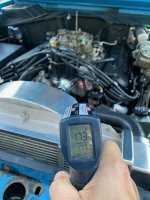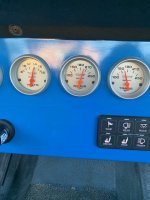I don't think anyone needs to prove it any more than you need to. You say it didn't work for you with a Jeep. I don't need proof, because you said it didn't work and I believe you. (usually! )
We're saying it can work on Broncos, and nobody needs to prove it to anyone. Just looking at the cooler temps (when it worked) would be enough for them to be fans of the methods. If they say it worked for them, I believe it.
If they say it did not work for them, I believe them too. But something not working for one does not negate the positive results of others. Never has...
Do all these solutions work every time for everyone? Certainly not! But they've worked often enough over the years, for enough people, that we know that they can work.
I can't help but think that the aerodynamics under the hood of a Jeep are far different from those of a Bronco. I don't know it, but it feels right to say it.
And I can't remember any great lengthy discussions on Jeep forums or among Jeep friends about overheating at trail speeds. Sure, it happens there too. But not nearly as often as we heard it about Broncos. So there seems to be a distinct difference in cooling performance on the trails.
And to this day, I've never seen a Jeep that needed it's hood removed and strapped to the roof to keep the engine cool on the trail. Yet I've seen Bronco hoods strapped up top since the early seventies.
Something is different between the two vehicles then. Engine performance? Engine cooling system design? Cooling capacity? Fan performance? Aero under the hood? All of the above?
Does opening the fenders, or hood, or ducting the radiator, or adding capacity, or changing design and materials, changing fan types, always help keep a Bronco cooler? Nope, we've seen plenty of discussions about how electric fans were not enough, bigger radiators were not enough, baffling and ducting the fans were not enough, changing engine tune was not enough, changing gearing, or transmission cooling methods were not enough. to know that the cure for one does not work for another.
But to make a blanket statement of disbelief does not make sense. If someone said it worked for them, why try to say they're wrong?
If it did not work for another, or perhaps did not work for you, then you did not have the same problem or did not have the same setup.
Every Bronco is STILL different!
Speaking of disagreeing, a double or triple-pass radiator does not impede coolant flow to the point that it hurts performance. I traded a standard heavy duty 4-row radiator for a triple-pass without doing anything else and my temps dropped immediately. Of course, it stopped leaking too, which was really the only reason I changed the radiator in the first place. I wasn't overheating, just leaking. But the new one ran cooler without a doubt.
Was it just the radiator? Can't say, as the temps don't even come up to the thermostat rating anymore. So maybe at the same time I changed the radiator, my thermostat decided to get stuck? Maybe, and I'm always going on about "coincidental failures" happening with our rigs.
The multi-pass radiators were designed way back and probably by racers to meet a certain criteria. Still use them I think, but maybe they found it does slow down flow too much for their liking? Don't know, since I don't hang out in racing circles much anymore.
To my knowledge though, I've never heard of one creating a heating issue where it did not exist before.
No matter though, since I'M happy with mine. Other's results may vary however.
Paul












